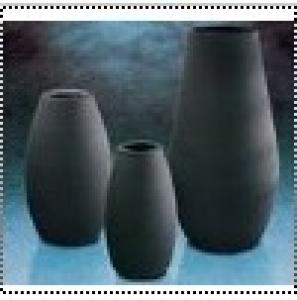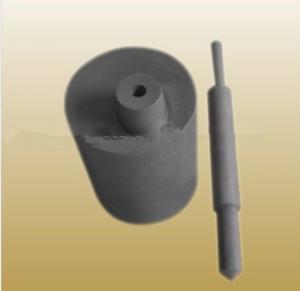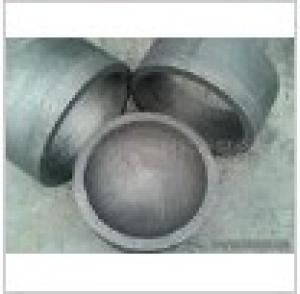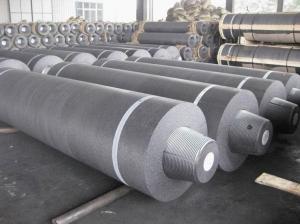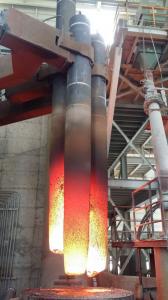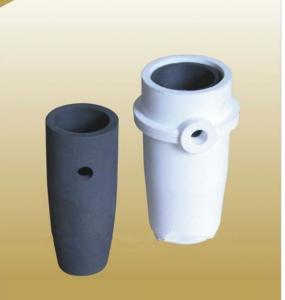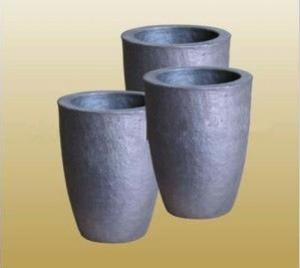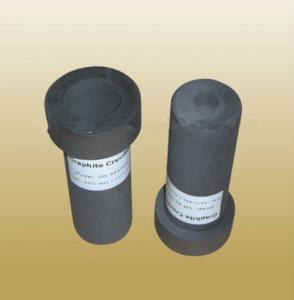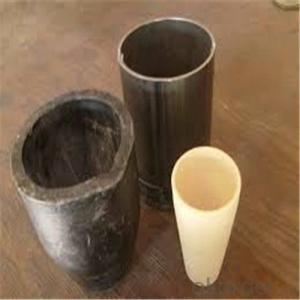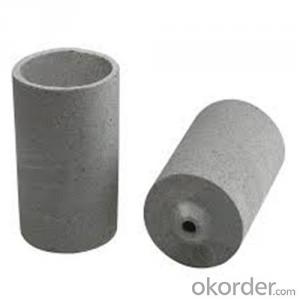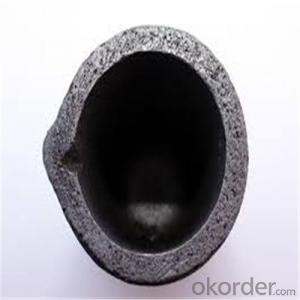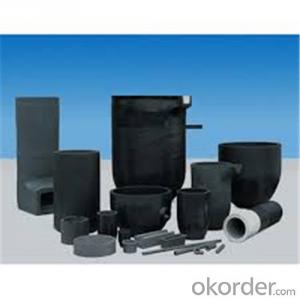Graphite Crucible
- Loading Port:
- China Main Port
- Payment Terms:
- TT or LC
- Min Order Qty:
- 50 Sets set
- Supply Capability:
- 5000 Sets per Month set/month
OKorder Service Pledge
Quality Product, Order Online Tracking, Timely Delivery
OKorder Financial Service
Credit Rating, Credit Services, Credit Purchasing
You Might Also Like
Detailed Product Description
graphite crucible is featured by fast heat conduction,long service life and low cost and the product finds good application
1.Garphite crucible can withstand the high temperature, an has good resistance to chemical erosions and thermal shock.
2.Graphite crucible is ideal for the melting of gold,silver,aluminum,copper and other metals and is also used as a tool for smelting jewelry.
- Q:What are the technical specifications of graphite crucibles?
- Graphite crucible has the characteristics of high temperature resistance, large volume density, thermal shock resistance, corrosion resistance, acid and alkali corrosion resistance, high efficiency, energy saving, environmental protection, high efficiency, low loss and so on.
- Q:Can a graphite crucible be used for melting non-metallic materials?
- Yes, a graphite crucible can be used for melting non-metallic materials. Graphite is a highly versatile material that can withstand high temperatures, making it suitable for melting various substances, including non-metallic materials. Graphite crucibles are commonly used in industries such as glass manufacturing, ceramics, and melting of precious stones. The high heat resistance of graphite allows it to endure the intense temperatures required for melting non-metallic materials, providing a reliable and efficient option for these applications.
- Q:How does the wall thickness of a graphite crucible affect the melting process?
- The wall thickness of a graphite crucible plays a significant role in the melting process. The thickness of the walls determines the heat transfer rate and the overall efficiency of the crucible. A thicker wall will have a higher thermal mass, meaning it can absorb and retain more heat. This can be advantageous in certain applications where a gradual and controlled heating or cooling process is desired. The increased thermal mass helps to stabilize the temperature and prevent rapid fluctuations, which can be detrimental to the melting process. On the other hand, a thinner wall will have a lower thermal mass and can facilitate faster heat transfer. This can be beneficial when quick and efficient melting is required. The thinner walls allow for faster heat transfer to the material being melted, resulting in shorter melting times and increased productivity. However, it is important to note that a thinner wall may also be more susceptible to thermal stress and cracking due to the higher temperature differentials between the inside and outside of the crucible. This can lead to potential contamination of the melted material or even failure of the crucible itself. Additionally, the wall thickness affects the overall durability and lifespan of the crucible. Thicker walls are generally more resistant to wear and tear, providing a longer operational life. This is particularly important in high-temperature applications where the crucible is subjected to extreme conditions. In summary, the wall thickness of a graphite crucible has a direct impact on the melting process. Thicker walls provide better temperature stability but may lead to longer melting times, while thinner walls allow for faster heat transfer but may be more prone to thermal stress. The choice of wall thickness depends on the specific requirements of the melting process and should be carefully considered to achieve optimal results.
- Q:Are graphite crucibles suitable for rapid prototyping processes?
- No, graphite crucibles are not suitable for rapid prototyping processes. Graphite crucibles are commonly used for melting and casting processes due to their high melting point and excellent heat resistance. However, for rapid prototyping, materials like plastic or metal are typically used, as they can be easily molded or machined to create prototypes quickly and accurately.
- Q:What are the different methods of monitoring the melting process in a graphite crucible?
- There are several methods available for monitoring the melting process in a graphite crucible. These methods can provide valuable information about the temperature, consistency, and progress of the melting process. 1. Visual Inspection: One of the simplest methods is to visually inspect the melting process. This can be done by observing the color, consistency, and movement of the materials being melted. For example, if the materials are turning into a liquid state and flowing smoothly, it indicates that the melting process is progressing as expected. 2. Thermocouples: Thermocouples are widely used for temperature measurement in various industrial processes, including melting in graphite crucibles. These devices consist of two different metals joined together at one end. By measuring the voltage difference between the two ends, the temperature can be determined. Thermocouples can be inserted into the crucible or placed near it to monitor the temperature accurately. 3. Infrared Pyrometers: Infrared pyrometers are non-contact temperature measurement devices that use infrared radiation to determine the temperature of an object. They can be used to monitor the temperature of the graphite crucible during the melting process without physically touching it. Infrared pyrometers provide quick and accurate temperature readings. 4. Optical Emission Spectroscopy (OES): OES is a technique that analyzes the light emitted by the materials being melted to determine their composition and temperature. By analyzing the spectral lines and intensities of the emitted light, OES can provide valuable information about the melting process, including temperature and the presence of impurities or alloying elements. 5. Pressure Measurement: Monitoring the pressure inside the graphite crucible can also be an indicator of the melting process. As the materials melt and vaporize, the pressure inside the crucible may increase. Pressure sensors can be employed to measure the pressure changes during the melting process, providing insight into the progress of the melting and the behavior of the materials. These methods can be used individually or in combination to monitor the melting process in a graphite crucible. By employing one or more of these techniques, operators can ensure that the melting process is proceeding as intended and make any necessary adjustments or interventions to maintain optimal conditions.
- Q:Is it possible to achieve controlled pouring with a graphite crucible?
- Controlled pouring using a graphite crucible is indeed achievable. Various industries, such as metal casting and melting, widely utilize graphite crucibles due to their unique properties. These crucibles possess a high melting point, excellent thermal conductivity, and good resistance to thermal shock, making them suitable for handling high-temperature substances. To achieve controlled pouring with a graphite crucible, several factors must be taken into account. Firstly, it is essential to adequately preheat the crucible to the desired pouring temperature. This ensures that the molten material maintains its desired temperature throughout the pouring process, preventing premature solidification. Secondly, the design of the crucible and its pouring lip should enable precise control over the flow of the molten substance. Shaping the pouring lip allows for a steady and controlled stream, reducing the risk of splashing or spilling. Moreover, the operator's expertise and experience play a vital role in achieving controlled pouring. They must possess a comprehensive understanding of the poured material, its characteristics, and the appropriate pouring techniques. Additionally, they should be mindful of potential hazards and take necessary precautions to ensure safety throughout the pouring procedure. In conclusion, achieving controlled pouring with a graphite crucible is feasible by considering proper preheating, suitable crucible design, and skilled operators. These factors contribute to achieving precise and controlled pouring for a variety of applications.
- Q:What are the different methods of preventing thermal shock in a graphite crucible?
- There are several methods that can be employed to prevent thermal shock in a graphite crucible. 1. Preheating: One of the most effective ways to prevent thermal shock is to preheat the graphite crucible before introducing it to high temperatures. By gradually increasing the temperature, the crucible can expand more evenly, reducing the risk of cracks or fractures due to sudden temperature changes. 2. Gradual cooling: Similarly, after use, it is essential to cool down the graphite crucible gradually. Placing it in a controlled environment or using a cooling chamber can help prevent rapid temperature changes, which can lead to thermal shock. 3. Avoiding direct flame contact: Exposing the graphite crucible directly to an open flame can cause localized hotspots and temperature gradients, increasing the likelihood of thermal shock. To prevent this, it is advisable to use indirect heating methods, such as placing the crucible in a furnace or using a heating mantle. 4. Insulating materials: Using insulating materials, such as ceramic fiber blankets or coatings, can help to reduce the heat transfer rate to the graphite crucible. This insulation can help mitigate sudden temperature changes and minimize the risk of thermal shock. 5. Proper handling: Careful handling of the graphite crucible is crucial to prevent thermal shock. Avoiding dropping or banging the crucible against hard surfaces can prevent potential damage and cracks. Additionally, using appropriate lifting tools or tongs designed for graphite crucibles can minimize the risk of mishandling. 6. Controlled heating and cooling rates: When subjecting the graphite crucible to high temperatures, it is important to control the heating and cooling rates. Rapid or uneven temperature changes can cause thermal stress and result in thermal shock. Employing temperature controllers or ramping up/down the temperature gradually can help reduce the likelihood of thermal shock. By implementing these methods, the risk of thermal shock in a graphite crucible can be significantly reduced, ensuring its longevity and reliability in various high-temperature applications.
- Q:Can a graphite crucible be used for powder injection molding?
- Yes, a graphite crucible can be used for powder injection molding. Graphite is a popular choice for crucibles in various high-temperature applications due to its excellent thermal conductivity, high melting point, and low chemical reactivity. In powder injection molding, a graphite crucible can withstand the high temperatures required for the process, typically ranging from 1300 to 1600 degrees Celsius. Additionally, graphite crucibles provide good resistance to thermal shock and can effectively contain the molten feedstock during the injection molding process. Overall, using a graphite crucible in powder injection molding is a suitable option due to its favorable characteristics and compatibility with the required operating conditions.
- Q:Who knows the method for determining the total iron content in iron ore?
- Iron is one of the most widely distributed metal elements in the earth, with an average content of 5% in the earth's crust and fourth after oxygen, silicon and aluminum in the element abundances. Iron minerals in nature are known to have 300 kinds, but in the current technical conditions, with industrial utilization value is mainly magnetite (iron containing 72.4% Fe3O4 (Fe2O3), hematite iron containing 70% (FeCO3) and siderite iron containing 48.2% (Fe2O3 / nH2O), limonite iron containing 48% ~ 62.9%).
- Q:Can graphite crucibles be used for electron beam melting processes?
- Graphite crucibles are indeed capable of being used in electron beam melting processes. They possess exceptional thermal conductivity, a high melting point, and commendable resistance to chemical attack, rendering them appropriate for high-temperature applications like electron beam melting. The remarkable thermal conductivity of graphite aids in the effective transfer of heat, thereby enabling uniform heating and melting of the material. Moreover, graphite crucibles exhibit excellent dimensional stability, a vital factor in ensuring precise control over the melting process. Consequently, graphite crucibles are widely favored in electron beam melting processes due to their advantageous attributes.
Our products are sold all over the country, and exported to America, Germany, Spain, India, Japan and Korea. Besides, we have strict management and advanced production technology.
We promise we will win more clients and a larger market with honest commercial credit, high quality of products, competitive price and good service.
1. Manufacturer Overview |
|
|---|---|
| Location | Inner Mongolia,China (Mainland) |
| Year Established | 2006 |
| Annual Output Value | US$2.5 Million - US$5 Million |
| Main Markets | 7.14% North America 7.14% South America 7.14% Eastern Europe 7.14% Southeast Asia 7.14% Africa 7.14% Oceania 7.14% Mid East 7.14% Eastern Asia 7.14% Western Europe 7.14% Central America 7.14% Northern Europe 7.14% Southern Europe 7.14% South Asia 7.14% Domestic Market |
| Company Certifications | |
2. Manufacturer Certificates |
|
|---|---|
| a) Certification Name | |
| Range | |
| Reference | |
| Validity Period | |
3. Manufacturer Capability |
|
|---|---|
| a)Trade Capacity | |
| Nearest Port | Xingang,Tianjin |
| Export Percentage | 31% - 40% |
| No.of Employees in Trade Department | 21-50 People |
| Language Spoken: | English, Chinese |
| b)Factory Information | |
| Factory Size: | 1,000-3,000 square meters |
| No. of Production Lines | 7 |
| Contract Manufacturing | 1,000-3,000 square meters |
| Product Price Range | Low and/or Average |
Send your message to us
Graphite Crucible
- Loading Port:
- China Main Port
- Payment Terms:
- TT or LC
- Min Order Qty:
- 50 Sets set
- Supply Capability:
- 5000 Sets per Month set/month
OKorder Service Pledge
Quality Product, Order Online Tracking, Timely Delivery
OKorder Financial Service
Credit Rating, Credit Services, Credit Purchasing
Similar products
New products
Hot products
Hot Searches
Related keywords
